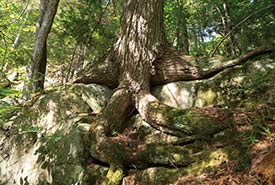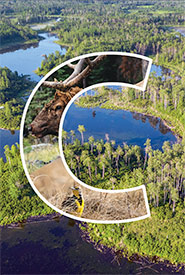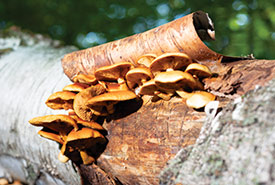Making connections

Connection is visible throughout nature, like here, between tree, rock, land and sky in Kenauk. (Photo by Guillaume Simoneau)
Collaboration between conservationists is helping create meaningful outcomes in habitat preservation, education and research.
By Dominique Ritter, writer and editor
In summer, King Kong sticks close to his home range. The eight-and-a-half-year-old bull moose — who earned his nickname thanks to his imposing stature — spends his nighttime hours feeding on new-growth poplars and beech. During the warm daytime hours, he can be found digesting in the shade of large fir trees, reclined on a cool, moist bed of moss, with his legs tucked up by his belly and the left side of his 140-centimetre antlers, with its signature downward-facing tine, resting on the ground to support his handsome head.
This munching-and-napping routine all sounds quite leisurely until you consider the effort of eating 22 to 25 kilograms of vegetation per day, not to mention the substantial challenges ahead. Because, come fall, King Kong will set off on a vital journey: fathering next year’s calves. Starting in the first days of September, King Kong transforms from homebody to travelling salesman. From his tract in the Kenauk nature reserve, in southwest Quebec, he has to signal to the female moose in the area that he is ready, willing. It’s time to roam the deep temperate forest.
King Kong begins his fall pilgrimage by covering about 10 square kilometres to rub his molting antlers, which have been carefully doused in his testosterone-accented urine, on trees. It’s not unusual for five or six females to come calling in response to this olfactory marketing campaign. It’s also not unusual for several young bulls to travel to King Kong’s patch and try to persuade a female that the big bull isn’t quick enough to satisfy. All to say that while most moose don’t typically migrate, they do move around — quite a bit. And this freedom to move is absolutely essential to their health, their ability to successfully reproduce and the population’s long-term survival, especially on a warming planet. Accommodating that movement is one of the key considerations when conservationists talk about ecological connectivity.
Building a network

Photo de Sean Feagan/CNC. Médaillon : Doug Dersken, Leta Pezderic/CNC
A common set of guiding principles is indispensable if conservationists are to work toward shared goals that translate across ecosystems and boundaries to create long-term solutions. To that end, most systematic conservation plans worldwide — including those of the Nature Conservancy of Canada (NCC) — follow four key principles: connectivity, adequacy, representation and effectiveness (often referred to by the acronym CARE). “Connectivity is about how much landscapes allow species to move and ecosystem processes to occur. It’s directly related to resilient landscapes and the genetic diversity of populations,” explains Marie-Andrée Tougas-Tellier, project manager for NCC and its Quebec Ecological Corridors Initiative (QECI).
We’re at the edge of the 93-hectare Lac Maholey, in Kenauk. It’s a rich source of the aquatic plants King Kong likes to eat in springtime. Looking out over a floating blanket of lily pads, there’s a great blue heron poised knee-deep in the shallows, searching for its next catch. The only human-made structure in view is the dock beneath our feet. But while this is ideal habitat for moose, they also need safe corridors to help them travel over wide expanses. Because of the area’s exceptional natural values, NCC has been partnering with the Kenauk Institute since 2013 to ensure its long-term care. At 26,500 hectares, it is one of the largest temperate forests dedicated to conservation and research in North America and significant habitat for species (112 rare species have been identified here in the past eight years).

Photo by Guillaume Simoneau
Kenauk also is important because it’s a crucial piece in a much wider natural network. This 300-kilometre corridor, which stretches between the Adirondacks and Parc Mont-Tremblant, is vital to species — from Canada warbler to painted turtle, to wolf and black bear. People power Cary Hamel, NCC’s director of conservation in Manitoba, has spent close to three decades protecting land and easing the passage of wildlife from one area to another. One of his team’s challenges: continuing to conserve important habitats and restore connectivity in key areas between Riding Mountain National Park, about 250 kilometres northwest of Winnipeg, and Duck Mountain Provincial Park, to its north. “At the end of the day, if those parks end up being islands, completely developed all around, they’re going to lose ecological integrity and they’re going to lose species,” Hamel explains. Success in NCC’s conservation efforts isn’t dependent on keeping humans out; it’s dependent on bringing them in.
“People are part of nature,” he says. With that in mind, Hamel and his team have been working within the Blue Wing corridor, a 106,578-hectare area separating Riding Mountain and Duck Mountain. Here, maintaining habitat for golden-winged warbler, moose and elk amid tracts of privately owned land is largely focused on building relationships in the community, based on shared values. Improving connectivity can look like the purchase of a piece of land or a conservation agreement in a critical movement corridor. But it can also be about innovative programs to help maintain grasslands and pastures and support livestock farmers, whose lands might otherwise be converted. Or it can look like students from the Waywayseecappo Off-campus School who have been coming out and working with Elders and NCC staff since 2018. They do a wide range of handson activities that benefit conservation, including restoration work on NCC properties, with the goal of improving movement across landscapes.
“Our goal is to support vibrant rural communities where people can make a living, and nature is seen as part of the economy and not as a barrier to development,” says Hamel. Similarly in Quebec, NCC is leading an initiative to build alliances and accelerate its efforts. Launched in 2017, QECI is comprised of 10 organizations and hundreds of partners, and uses a collective approach to boost the conservation of ecosystems connected by natural corridors. The initiative includes municipal and regional governments, woodlot owners, farmers, environmental organizations and experts dedicated to protecting and conserving nature across borders. It’s a remarkable confluence of interests, not least of all because it’s the first time all key stakeholders have worked together on a common goal. Thanks to QECI, woodlot owners learn that their forest management work is also beneficial for wildlife corridors. And by leaving tree stumps and woody debris, they provide critical habitat for pileated woodpecker and salamander. In turn, NCC has learned much from woodlot owners, making it a mutually beneficial collaboration. “When we started, in 2017, not many people were working to conserve ecological connectivity,” reflects Kateri Monticone, director strategic conservation and innovation at NCC in Quebec. “Now we hear it referenced more and more — in government, among the owners of woodlots, citizens, regional mayors,” says Monticone. “That’s a really great achievement.”
This excerpt originally appeared in the fall 2023 issue of the Nature Conservancy of Canada Magazine.
Explore additional content from our spring issue here >
The Nature Conservancy of Canada Magazine is distributed to NCC donors and supporters who contribute $100 or more per year.




